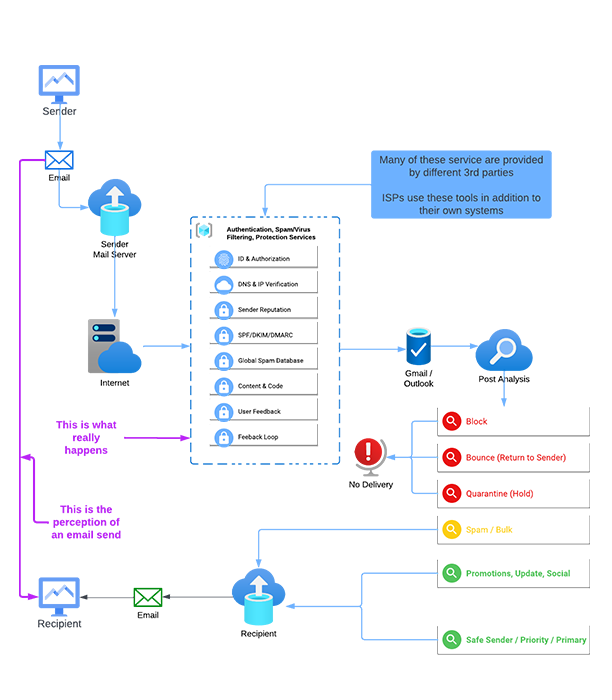Enter the backend of the internet! Today we will cover how some of the email processes work and how service providers like Gmail, Yahoo, Outlook, etc manage to deal with everyone's billions of daily email sends.
For most, the comprehension stops after they created an email and hit the "send" button. It's understood that when I draft an email, enter a recipient and click send that this person will receive your message. Simple concept, right? Sure, but not really.


The image on the left, breaks down how an email send is being executed on a very high level over simplified way. The vast majority of individuals are oblivious how the send mechnism really works and how companies use highly complex algorithms and policy rules to combat the neverending battle with spam, virus, malware, etc. The reason being is that email is still to this day the most effective and reliable way of communicating through out the internet. Image on the right provides a sample of what internet service providers see about you.
One of the biggest threats are email scams and spoofing
Are you familiar with SPF, DKIM, DMARC, Deliverability, Barracuda, Spamhaus, Reverse DNS, IP Warming, Block bounce, hard bounce, feedback loop, and many more? These are just a few components that you have to get right or your emails will go nowhere or straight into your bulk/spam folder. There are many ways you can mess up your Sender Score, which is similar to your credit score on the internet that is re-calculated with each email deployment tied to your sender domain/IP. If you are sending smaller volumes and use a general plan like a Mailchimp, your email deployments are monitored by the ESP whereas bigger organziation are responsible to manage their own because the amount of volume they send.
Spam accounts for 45% of all emails sent. Spam earns Senders around $7000 per day and cost businesses a whopping $20.5 Billion every year
There several different protocols such as IMAP, SMTP and MTA and then there are countless different security features that require a verified sending infrastructure. The sending infrastructure is under scrutiny more now than ever because the reality is that you have to earn your email delivery with every email send. Just like credit, do something out of the ordinary today and there is an impact to your credit score that then determines your approval rating, your rates and so on. In email, a negative impact can be that your emails may be held in a quarantine for a while, until you satisfy the ISP with your other email sends.
Hit too many spam traps, honey pots, etc. ISP's will punish the sender by "Block bouncing" all of your email sends. "Block Bouncing" is a term used in the digital marketing industry when your sending domain and IP were blacklisted by ISP's and/or the global spam databases that many ISP's use to validate your IP and domain. The biggest "gotcha" on block bounces is that you generally don't have a clue that you are being blocked. ISP's don't give you a warning or let you know. You will eventually figure it out when your email open rates go to close to 0 because all of the email you are sending are being immediately rejected without even being delivered to the recipient. So they never know you sent and email.
What is a spam trap or honey pot? Those are special repurposed email address that used to belong to people that the ISP revoked from the user but keeps it active to monitor companies and their email campaigns and sends. This is their way of testing if companies follow the email CAN SPAM regulations and policies. ISPs frown on emails being sent to people that have no interest in your email as it is sort of considered spam (unwanted and repeat solicitation of emails). Unwanted in the ISP's definition is anyone, even if they signed up initially to your list but then stops engaging with your email. You send hundreds of emails to people but they never bother to look at it and let it just move down their inbox. That's a no no! It's like quiet quitting.





